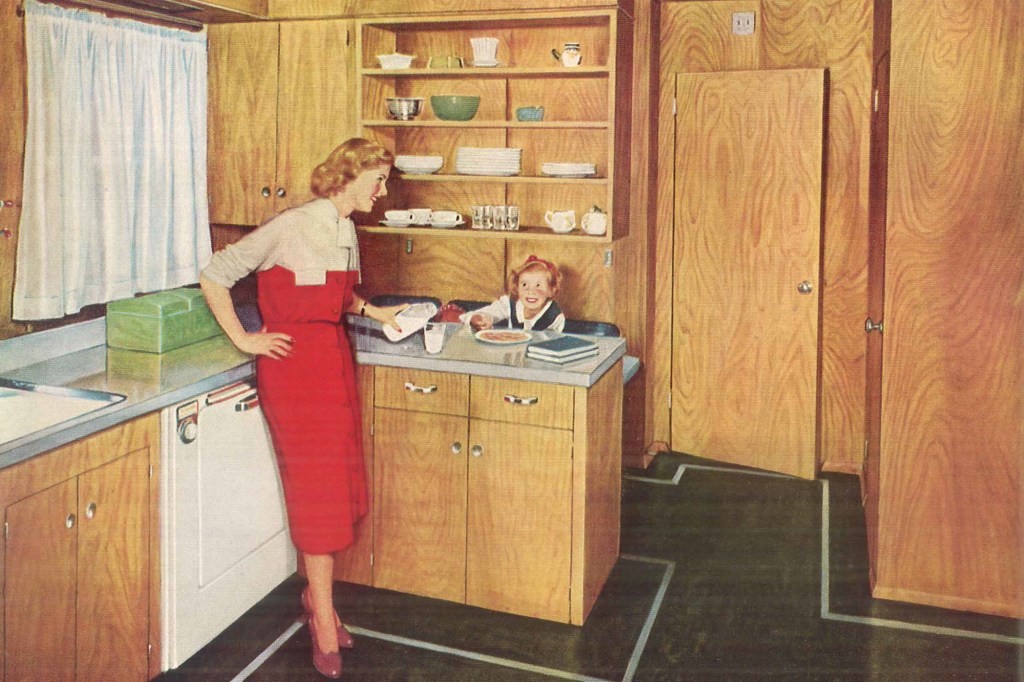This post is part of a monthly
series that explores the historical applications of building materials and
systems, using resources from the Building Technology Heritage Library (BTHL),
an online collection of AEC catalogs, brochures, trade publications, and more.
The BTHL is a project of the Association for Preservation Technology, an international building preservation organization. Read more about the
archive here.
Wood from North America’s great forests has long played a vital role in regional building traditions. From un-milled logs to glue-laminated beams and plywood, architects, builders, and manufacturers alike have found ways to use structural and finish wood products in buildings of all sizes. The material, ubiquitous in furniture and interior finishes, remains the predominant structural component for single-family residential construction; more recently, it is being taken to new heights in tall-building construction. Trade catalogs, pamphlets, and brochures housed in the digital Building Technology Heritage Library (BTHL) document the material’s long history in structural framing, ornamental woodwork, architectural finishes, and furniture. Several millwork catalogs from the early 20th century are particularly comprehensive and feature wood in doors, windows, moldings, and other ornamentation as well as woven-wood fences, structural laminated timbers, wood tanks, and marquetry. The following nine historical texts help illustrate the evolution of the North American wood-products industry.
Heavy Timber Mill Construction Buildings, National Lumber Manufacturer’s
Association, 1920
This
publication of the National Lumber Manufacturer’s Association is part of a technical
series on mill construction, which it defines as a “type of building construction in
which interior framing and floors are [made] of timber, arranged in heavy solid
masses and smooth flat surfaces.” The organization further refined the definition by adding caveats on fire safety through “incombustible walls and partitions,” amended with
a cautionary warning that an “automatic sprinkler system is of great
importance.”
From Tree to Trade, Long-Bell Lumber Co., 1920
The story of
how a tree becomes a building material is illustrated in this
publication from the Long-Bell Lumber Co. of Kansas City, Mo.
Its lumber camp and lumber mills are showcased in the brochure, along with the various
uses of wood for construction.
General Catalog, Segelke & Kohlhaus Mfg Co., 1911–1912
This early-20th century, 515-page catalog presents a comprehensive overview
of architectural woodwork available for both commercial and residential
buildings. Ephemera like this tend to feature items that were
architecturally fashionable decades earlier and still available or in use due to their ubiquity. This catalog, produced by publisher Rand McNally,
could be customized with the name of the local lumber yard, which would
distribute the pamphlet to its builder customers.
Beautiful Wood for Beautiful Homes with Weldwood Plywood, U.S. Plywood Corp., New York, 1953
Fused-veneer
wood sheets, marketed under the trade name Plywood, were an innovation of the
20th century that remains today among the most common building materials. This
catalog explores its use in framing and decorative finishes.
Wholesale Catalog 159: America’s Most Complete Building Supply
House, Morgan
Wightman Building Materials, 1959
Independent
building-material suppliers today face fierce pressure from big-box
home-improvement retailers that can at times overlook their rich history as the
primary conduit for building-product sales. Dealers such as Morgan Wightman
Building Supply would create catalogs detailing their product inventory, which often included veneered panels along with traditional millwork items.
How to Identify Genuine Mahogany and Avoid Substitutes, George N. Lamb, Mahogany
Associates, 1940
There exist—and have existed—more than a few wood-related trade groups specifically for
hardwoods. Among them was the Mahogany Association, which represented wood
producers in Central America, South America, the Caribbean, and Africa, and
advised consumers on how to spot real mahogany versus a non-authentic
representation of the material. Additionally, this informational volume features
color plates showing pattern variations, which were particularly important to
furniture makers.
Building with Assurance, Morgan Woodwork Associates, 1921
This comprehensive
and beautifully illustrated catalog from the 1920s showcases how woodwork was
incorporated into residential architecture in an era that saw a range of popular
architectural styles, including Colonial, Craftsman, Mission, and Modern. This
volume also features a section of house plans.
Architectural Details for Every Type of
Building: a Practical Drafting Room Guide for Contractors, Builders, Lumber Dealers,
Millmen, Draftsmen, and Architects, William A. Radford, 1921
The Radford
Architectural Co. published carpentry manuals, building guides, plans books,
and periodicals during the first three decades of the 20th century. This
particular volume includes line illustrations of architectural framing and trim
for houses, small commercial buildings, and farm structures. Most of Radford’s publications
are available through the BTHL.
Rilco Laminate Wood Products, Rilco Laminated Products, 1961
Laminating
wood members to create structural beams was an innovation that enabled longer clear
spans and was particularly popular in religious
buildings. The material was introduced in the 1930s and reached peak use in the 1950s and ’60s, though it remains popular to this day.
